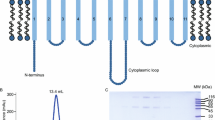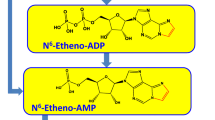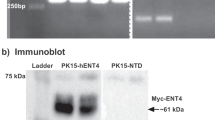Summary
Equilibrium binding of [3H]dipyridamole identified high-affinity (K i ∼10nm) binding sites on human erythrocytes (∼5×105 sites/cell) and on HeLa cells (∼5×106 sites/cell). The equilibration of dipyridamole with these sites on human erythrocytes was compatible with a second-order process which proceeded at 22°C with a rate constant of about 6×106 m −1 sec−1. Binding of dipyridamole to these sites correlated kinetically with the inhibition of the equilibrium exchange of 500 μm uridine in these cells and was inhibited in a concentration-dependent manner by nucleosides and other inhibitors of nucleoside transport, such as nitrobenzylthioinosine, dilazep and lidoflazine, but not by hypoxanthine, which is not a substrate for the nucleoside transporter of human erythrocytes. The results indicate that the substrate binding site of the transporter is part of the high-affinity dipyridamole binding site. Bound [3H]dipyridamole became displaced from these sites on human erythrocytes by incubation with an excess of unlabeled dipyridamole or high concentrations of nucleosides and inhibitors of nucleoside transport, but neither by hypoxanthine nor sugars. Dissociation of [3H]dipyridamole behaved as a simple first-order process, but the rate constant was about one order of magnitude lower (about 3×10−3 sec−1) than anticipated for typical ligand-protein binding on the basis of the measured association rate and equilibrium constants. The reason for this discrepancy has not been resolved. No high-affinity dipyridamole binding sites were detected on Novikoff rat hepatoma cells, P388, L1210 and S49 mouse leukemia cells or Chinese hamster ovary cells, and their absence correlated with a greater resistance of nucleoside transport in these cells to inhibition by dipyridamole. All cells expressed considerable low affinity (K d>0.5 μm) and nonspecific binding of dipyridamole.
Similar content being viewed by others
References
Belt, J.A. 1983. Heterogeneity of nucleoside transport in mammalian cells. Two types of transport activity in L1210 and other cultured neoplastic cells.Mol. Pharmacol. 24:479–484
Belt, J.A., Noel, L.D. 1985. Nucleoside transport in Walker 250 rat carcinoscarcoma and S49 mouse lymphoma cells.Biochem. J. 232:681–688
Berne, R.M., Rall, T.W., Rubio, R., editors. 1983. Regulatory Functions of Adenosine. Martinus Nijhoff, Boston, Mass.
Cabral, S., Leis, S., Bover, L., Nembrot, M., Mordoh, J. 1984. Dipyridamole inhibits reversion by thymidine of methotrexate effect and increases drug uptake in sarcoma 180 cells.Proc. Natl. Acad. Sci. USA 81:3200–3203
Cass, C.E., Dahlig, E., Lau, E.Y., Lynch, T.P., Paterson, A.R.P. 1979. Fluctuation in nucleoside uptake and binding of the inhibitor of nucleoside transport, nitrobenzylthioinosine, during replication cycle of HeLa cells.Cancer Res. 39:1245–1252
Deuticke, B., Duhm, J., Gerlach, E. 1964. Beinflussung der Monosaccharide-Permeabilitaet des Menschen Erythrozyten durch eine Pyrimidopyridin-Verbindung.Pfluegers Arch. 280:275–280
Eilam, Y., Cabantchik, I. 1977. Nucleoside transport in mammalian cell membranes: A specific inhibitory mechanism of high affinity probes.J. Cell. Physiol. 92:185–202
Green, J.L., Fisher, P.H. 1986. Augmentation of 5′-fluorouracil cytotoxicity in human colon cancer cells by dipyridamole.Cancer Res. 45:2967–2972
Hammond, J.R., Paterson, A.R.P., Clanachan, A.S. 1981. Benzodiazepine inhibition of site-specific binding of nitrobenzylthioinosine, an inhibitor of adenosine transport.Life Sci. 29:2207–2214
Jarvis, S.M., Ellory, J.C., Young, J.D. 1986. Radiation inactivation of the human erythrocyte nucleoside and glucose transporters.Biochim. Biophys. Acta 855:312–315
Jarvis, S.M., Fincham, D.A., Ellory, J.C., Paterson, A.R.P., Young, J.D. 1984. Nucleoside transport in human erythrocytes. Natrobenzylthioinosine binding and uridine transport activities have similar radiation target size.Biochim. Biophys. Acta 772:227–230
Jarvis, S.M., Hammond, J.R., Paterson, A.R.P., Clanachan, A.S. 1983a. Nucleoside transport in human erythrocytes. A simple carrier with directional symmetry in fresh cells but directional asymmetry in cells from outdated blood.Biochem. J. 210:457–461
Jarvis, S.M., Janmohamed, S.N., Young, J.D. 1983b. Kinetics of nitrobenzylthioinosine binding to the human erythrocyte nucleoside transporter.Biochem. J. 216:661–667
Jarvis, S.M., McBride, D., Young, J.D. 1982. Erythrocyte nucleoside transport: Asymmetrical binding of nitrobenzylthioinosine to nucleoside permeation sites.J. Physiol. (London) 323:31–46
Kang, G., Kimball, A.P. 1984. Dipyridamole enhancement of toxicity to L1210 cells by deoxyadenosine and deoxycoformycin in vitro.Cancer Res. 44:317–326
Koren, R., Cass, C.E., Paterson, A.R.P. 1983. The kinetics of dissociation of the inhibitor of nucleoside transport, nitrobenzylthioinosine, from the high-affinity binding site of cultured hamster cells.Biochem. J. 216:299–308
Laemmli, U.K. 1970. Cleavage of structural proteins during the assembly of the head of bacteriophage T4.Nature (London) 227:680–685
Lauzon, G.J., Paterson, A.R.P. 1977. Binding of the nucleoside transport inhibitor nitrobenzylthioinosine to HeLa cells.Mol. Pharmacol. 13:883–891
Mahony, W.B., Zimmerman, T.P. 1986. An assay for inhibition of nucleoside transport based upon the use of 5-[125I]iodo-2′-deoxyuridine as permeant.Anal. Biochem. 154:235–243
Marangos, P.Y., Houston, M., Montgomery, P. 1985. [3H]Dipyridamole: A new ligand probe for brain adenosine uptake site.Europ. J. Pharmacol. 117:393–394
Nelson, J.A., Drake, S. 1984. Potentiation of methotrexate toxicity by dipyridamole.Cancer Res. 44:2493–2496
Paterson, A.R.P., Kolassa, N., Cass, C.E. 1981. Transport of nucleoside drugs in animal cells.Pharmacol. Ther. 12:515–536
Paterson, A.R.P., Lau, E.Y., Dahlig, E., Cass, C.E. 1980. A common basis for inhibition of nucleoside transport by dipyridamole and nitrobenzylthioinosine.Mol. Pharmacol. 18:40–44
Plagemann, P.G.W. 1986. Transport and metabolism of adenosine in human erythrocytes: Effect of transport inhibitors and regulation by phosphate.J. Cell. Physiol. 128:491–500
Plagemann, P.G.W., Kraupp, M. 1986. Inhibition of nucleoside and nucleobase transport and nitrobenzylthioinosine binding by dilazep and hexobenzine.Biochem. Pharmacol. 35:2559–2567
Plagemann, P.G.W., Wohlhueter, R.M. 1980. Permeation of nucleosides, nucleic acid bases and nucleotides in animal cells.Curr. Top. Membr. Transp. 14:225–330
Plagemann, P.G.W., Wohlhueter, R.M. 1982. The hypoxanthine transporter of Novikoff rat hepatoma cells exhibits directional symmetry and equal mobility when empty or substrateloaded.Biochim. Biophys. Acta 688:505–514
Plagemann, P.G.W., Wohlhueter, R.M. 1983. Adenosine metabolism in wild-type and enzyme-deficient variants of Chinese hamster ovary and Novikoff rat hepatoma cells.J. Cell. Physiol. 116:236–246
Plagemann, P.G.W., Wohlhueter, R.M. 1984a. Nucleoside transport in cultured mammalian cells. Multiple forms with different sensitivity to inhibition by nitrobenzylthioinosine or hypoxanthine.Biochim. Biophys. Acta 773:39–52
Plagemann, P.G.W., Wohlhueter, R.M. 1984b. Kinetics of nucleoside transport in human erythrocytes. Alterations during blood preservation.Biochim. Biophys. Acta 778:176–184
Plagemann, P.G.W., Wohlhueter, R.M. 1985a. Nitrobenzylthioinosine-sensitive and- resistant transport in normal and transformed rat cells.Biochim. Biophys. Acta 816:387–395
Plagemann, P.G.W., Wohlhueter, R.M. 1985b. Effects of nucleoside transport inhibitors on the salvage of adenosine and deoxyadenosine in L1210 and P388 mouse leukemia cells.Cancer Res. 45:6418–6424
Plagemann, P.G.W., Wohlhueter, R.M., Erbe, J. 1982. Nucleoside transporter in human erythrocytes. A simple carrier with directional symmetry and differential mobility of loaded and empty carrier.J. Biol. Chem. 257:12069–12074
Rampal, A.L., Jung, E.K.Y., Chin, J.J., Deziel, M.R.F., Pinkofsky, H.B., Jung, C.Y. 1986. Further characterization and chemical purity assessment of the human erythrocyte glucose transporter preparation.Biochim. Biophys. Acta 859:135–142
Segel, I.H. 1975. Enzyme Kinetics. Chapter 3. Wiley, New York
Stein, W.D. 1986. Transport and Diffusion Across Cell Membranes. Academic, Orlando, Florida
Tse, C.M., Belt, J.A., Jarvis, S.M., Paterson, A.R.P., Wu, J.S., Young, J.D. 1985. Reconstitution of the human erythrocyte nucleoside transporter.J. Biol. Chem. 260:3506–3511
Wheeler, T.J., Hinkle, P.C. 1981. Kinetic properties of the reconstituted glucose transporter from human erythrocytes.J. Biol. Chem. 256:8907–8914
Wohlhueter, R.M., Brown, W.E., Plagemann, P.G.W. 1983. Kinetic and thermodynamic studies on nitrobenzylthioinosine binding to the nucleoside transporter of Chinese hamster ovary cells.Biochim. Biophys. Acta 731:168–176
Wohlhueter, R.M., Marz, R., Graff, J.C., Plagemann, P.G.W. 1978. A rapid-mixing technique to measure transport in suspended animal cells. Application to nucleoside transport in Novikoff rat hepatoma cells.Methods Cell. Biol. 20:211–236
Wohlhueter, R.M., Plagemann, P.G.W. 1982. On the functional symmetry of nucleoside transport in mammalian cells.Biochim. Biophys. Acta 689:249–260
Wu, J.S.R., Kwong, F.Y.P., Jarvis, S.M., Young, J.D. 1983. Identification of the erythrocyte nucleoside transporter as band 4.5 polypeptide. Photoaffinity labeling studies using nitrobenzylthioinosine.J. Biol. Chem. 258:13745–13751
Young, J.D., Jarvis, S.M. 1983. Nucleoside transport in animal cells.Biosci. Rep. 3:309–322
Zhen, Y., Lui, M.S., Weber, G. 1983. Effects of acivicin and dipyridamole on hepatoma 3924A cells.Cancer Res. 43:1616–1619
Author information
Authors and Affiliations
Rights and permissions
About this article
Cite this article
Woffendin, C., Plagemann, P.G.W. Interaction of [3H]dipyridamole with the nucleoside transporters of human erythrocytes and cultured animal cells. J. Membrain Biol. 98, 89–100 (1987). https://doi.org/10.1007/BF01871048
Received:
Revised:
Issue Date:
DOI: https://doi.org/10.1007/BF01871048




